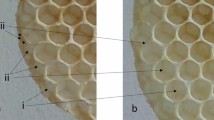Summary
Upon entering a new home site a honeybee swarm is faced with the task of organizing the building activities of thousands of component bees so that several straight and parallel vertically oriented combs can be quickly and efficiently built. As a part of this organization process it is necessary for the bees to select and agree upon a planar orientation for the new combs.
This paper presents evidence that memory of a previously used comb direction influences the building of the new set of combs. Swarms which have recently moved into bait-hives (empty boxes placed in trees to attract feral swarms) tend to maintain the previously used comb direction when removed and forced to build new combs, whereas swarms which have occupied the bait-hives for a longer period (over 9 days) do not.
Recent swarms predictably alter their comb building direction within the influence of an applied earthstrength magnetic field, indicating that honey bees are able to use the earth's magnetic field as a reference at the commencement of comb construction in a new hive.
Similar content being viewed by others
References
Batschelet E (1965) Statistical methods for the analysis of problems in animal orientation and certain biological rhythms. American Institute of Biological Sciences Monograph, Washington, DC
Batschelet E (1972) Recent statistical methods for orientation data. In: Galler SR et al. (eds) Animal orientation and navigation. National Aeronautics and Space Administration, Washington, DC, pp 61–91
Crane E (1974) Directions in which bees build combs. Bee World 55:153–155
Darwin C (1859) The origin of species by natural selection. Murray, London
Emlen ST (1975) Migration: Orientation and navigation. In: Farner DS, King JR, Parkes KC (eds) Avian biology, vol V. Academic Press, New York, pp 129–219
Emlen ST, Wiltschko W, Demong NJ, Wiltschko R, Bergman S (1976) Magnetic direction finding: evidence for its use in migratory Indigo Buntings. Science 193:505–508
Fraser HM (1951) Beekeeping in antiquity. University of London Press, London
Frisch K von, Frisch O von (1974) Animal architecture. Harcourt Brace Jovanovich, New York
Gibson RJ (1969) A monograph on magnetic fields for life scientists. National Aeronautics and Space Administration Report A-B2299-3, vol II
Gould JL (1980) The case for magnetic sensitivity in birds and bees (such as it is). Am Sci 68:256–267
Gould JL, Kirschvink JL, Deffeyes KS (1978) Bees have magnetic remanence. Science 201:1028
Huber F (1814) Nouvelles observations sur les abeilles, I, II. Hamilton, Illinois (New observations on bees, I, IL Translated by C.P. Dadant 1926. Hamilton, Illinois)
Ifantidis MD (1978) Wabenorientierung im Nest der Honigbiene (Apis mellifica L.) Apidologie 9:57–73
Lindauer M (1973) Das Magnetfeld der Erde als Orientierungshilfe für die Bienen. Imkerfreund 28:3–7
Lindauer M (1976) Recent advances in the orientation and learning of honeybees. Proc XV Int Congr Entomol, pp 450–460
Lindauer M, Martin H (1972) Magnetic effect on dancing bees. Symposium NASA SP-262, Animal Orientation and Navigation. US Government Printing Office, Washington, DC, pp 559–567
Martin H, Lindauer M (1966) Sinnesphysiologische Leistungen beim Wabenbau der Honigbiene. Z Vergl Physiol 53:372–404
Martin H, Lindauer M (1973) Orientierung im Erdmagnetfeld. Fortschr Zool 21:211–228
Martin H, Lindauer M (1977) Der Einfluß des Erdemagnetfeldes auf die Schwereorientierung der Honigbiene (Apis mellifera). J Comp Physiol 122:145–187
Rubens SM (1945) Cube surface coil for producing a uniform magnetic field. Rev Sci Instrum 16:243–245
Seeley TD (1977) Measurement of nest cavity volume by the honeybee (Apis mellifera). Behav Ecol Sociobiol 2:201–227
Seeley TD (1978) Life history strategy of the honey beeApis mellifera. Oecologia (Berl) 32:109–118
Seeley TD, Morse RA (1976) The nest of the honeybee. Insectes Soc 23:495–512
Seeley TD, Morse RA (1978) Nest site selection by the honeybeeApis mellifera. Insectes Soc 25:323–337
Wedmore EB (1948) The ventilation of beehives. Bee World 29:20
Werner-Meyer W (1960) Wachs and Wachsbau-Kittharz. In: Budel A, Herold E (eds) Biene und Bienenzucht. Ehrenwirth, München, pp 202–232
Author information
Authors and Affiliations
Rights and permissions
About this article
Cite this article
De Jong, D. Orientation of comb building by honeybees. J. Comp. Physiol. 147, 495–501 (1982). https://doi.org/10.1007/BF00612015
Accepted:
Issue Date:
DOI: https://doi.org/10.1007/BF00612015



